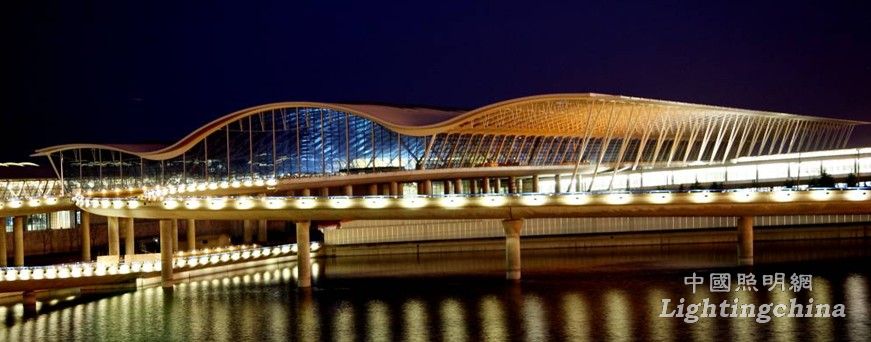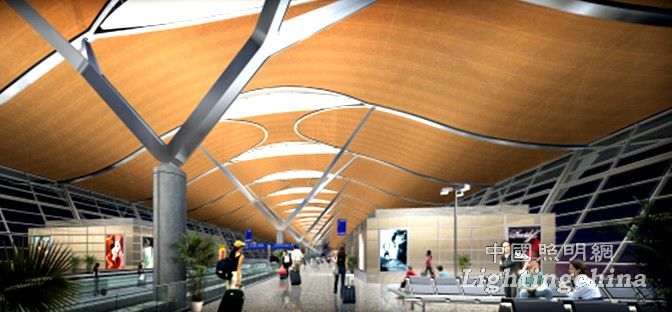1,2 (Modern Design Group East China Architectural Design and Research Institute Co., Ltd., Shanghai 200002)
3,4 (Philips China Investment Co., Ltd., Shanghai 201801)
Abstract: This paper expounds the lighting design concept of the lighting environment and airport building in the large space and the ideas and points of applying these concepts through the new Shanghai Pudong International Airport Phase II project .
Keywords: large space lighting, indoor light environment, energy saving
1. Overview Shanghai is the most important city on the eastern coast of China. It is located at the intersection of the economic development zone of the southeast coast and the economic belt of the Yangtze River Basin. It is the hub connecting the domestic and world economy and trade. The increasingly busy operation of Shanghai Airport has become its most direct performance. Pudong International Airport is located in the international large-scale aviation hub port, and the construction of the second phase terminal is the most important construction project in the second phase of the project. The second phase terminal is located on the east side of the first-stage terminal area. It is basically arranged symmetrically in the middle of the airport rail transit station. The structure is basically similar to that of the first-phase terminal building, with a total construction area of ​​nearly 500,000 square meters. The airport terminal is an architecturally complex and widely used building, and its lighting has become an important part of the building. The airport terminal building lighting is a combination of architectural landscaping, ergonomics and aviation safety. It is different from ordinary civil architectural lighting, but has higher requirements. It is of great significance for enhancing the image of the entire airport and has received great attention. The large space building in the terminal building refers to a public space with a particularly large space and area in the terminal building. Large space buildings play an increasingly important role in the ever-changing airport buildings. Sometimes it is difficult to design and implement, and as an important part of large space buildings - large space lighting, its design and implementation The pros and cons will directly affect the effect of the entire building.
Figure 1 Pudong Airport Terminal Real Shot Night Scene


There are two main public spaces in the second phase of the terminal building. One is located in the departure hall of the main building of 13.6 meters. The hall has huge space. There are two large curved roofs with a width of 137 meters, a length of 404 meters and a height of 12 to 26 meters. There are 88 leaf-type sunshade films on the top of the ceiling. The whole space is very simple and continuous. There are 10 check-in islands with a length of 60 meters, a width of 15 meters and a spacing of 36 meters. The other is the 13.6-meter international lounge hall on the promenade. The hall has a single curved roof with a 1062-meter long waiting area. It is supported by multiple single columns. The curved roof is 40 meters wide and 12 in height. ~17 meters. There is a leaf-shaped membrane with a spacing of 9 meters on the ceiling.
Figure 2 Departure Hall of the 13.6m floor of the main building

Figure 3 Promenade 13.6m International Waiting Hall

2. Designing and conceiving the lighting of the terminal building requires fulfilling all the functional requirements of different functional areas while achieving the aesthetic requirements, so that the perfect combination of lighting and architecture and decoration echoes each other. The design of the terminal of the second phase of the airport continues the overall concept of the first phase of the airport. It not only undertakes in the large space, but also emphasizes the transformation of different spatial forms in its internal space, as well as the structure, materials and A breakthrough in its details. The concepts in these architectural spaces are reinforced by the language of illumination: they are similar to those in the first phase of lighting design, but also in the details of different interior spaces.
The interior design of the second terminal is seeking a breakthrough. The design is based on the theme of “warm, intimate and quiet journeyâ€, which aims to break through the cool interior space of the previous terminal building and give warmth to the interior space. And with different details in different areas, leaving more warm memories and experiences for the travelers. Lighting design also needs to express the idea of ​​adding different special effects to the fixtures in different interior spaces.
An airport is a place where people leave or arrive at a city (or even a country), leaving memories of the city (country) or creating an initial feeling. As it leaves the check-in or arrives at the gate, all the details in the flow of different spaces are subtly increasing his awareness of the city (country). As the fourth dimension of architecture, light should also be emphasized in detail: emphasizing the guiding role of light and adding some symbols and memories of China or Shanghai.
3. Design Principles The large space lighting of the terminal building has different characteristics and functional requirements from other architectural lighting.
1. Lighting should be designed according to different regions and different functional requirements to provide a good visual environment for passengers and staff in different regions. Choose reasonable lighting fixtures, appropriate lighting methods, and accurately control various lighting indicators, including illuminance, brightness, glare, color rendering and other parameters, so that it truly meets the needs of people for lighting functions.
2. In addition to meeting its functional requirements, lighting needs to be perfectly integrated with the built environment and interior design, and fully apply various lighting means to express the interior and exterior image of the building, highlight the characteristics of the built environment, and use appropriate lighting fixtures. People provide a reasonable, healthy and comfortable lighting environment.
3. Lighting also configures reasonable lighting fixtures and light sources according to the special requirements of the terminal building and the characteristics of large space buildings to meet the needs of indoor lighting.
4. At the same time, it is necessary to meet the requirements of the guiding lighting function of the high traffic flow of the airport, use the brightness and color temperature of the light to change the space, guide the flow of people, and form a reasonable light induction.
5. Select high-efficiency, energy-saving lamps and accessories, use appropriate lighting methods according to the functional area, and properly set the installation position of the lamps; and use flexible lighting control methods according to time and people flow; use natural light as much as possible during the day.
4. Lighting Standards The national "Architectural Lighting Design Standards" (GB50034-2004) implemented in China put forward detailed index values ​​for the illumination level, glare and glare control and color rendering of airport buildings. The illuminance level is guaranteed to provide sufficient light and illumination in the airport building to effectively, safely and comfortably meet the lighting requirements of the visual functions of the basic activities of staff and passengers. However, the author believes that the illuminance level of the non-working part of the lobby, passage, waiting area, etc. in the airport building is not required or necessary. The level of illuminance is not the only basis for measuring or embodying the entire space lighting design, while other lighting quality standards, such as the visual perception of the human eye, the influence of indoor light environment, the control of glare, the uniformity and the color rendering, etc. Comprehensive factors can truly satisfy people's physiological and psychological needs.
In addition, the good lighting design not only fully reflects the level of lighting indicators, but also through the space lighting and lighting settings, highlighting the effect and beauty of the building, creating an atmosphere and improving passenger comfort and satisfaction.